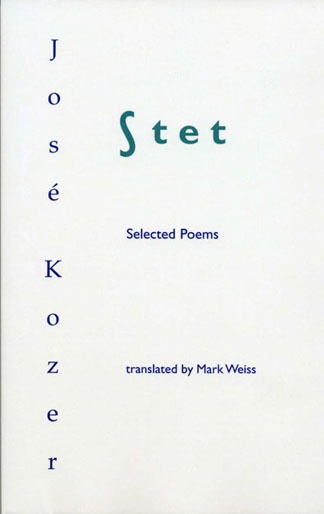

Stet: Selected Poems
José Kozer
Bilingual. Translated, edited, and with an introduction by Mark Weiss

222 pages perfectbound
$20.00
ISBN: 1-881523-09-8
The poetry of Kozer, in this beautifully selected & translated edition, moves from a particular person & place (Cuban, Jewish,
caught between home & exile) into a tangle of locations & perceptions that gives his poetry a nearly epic status. While the
work has an avant-garde (“neobaroque”) foundation – & it does – it’s the humanity of the writing (passionate & comic by
turns & always precisely referential) that predicts its lasting greatness. A resident of America & of the world, José Kozer is a
poet who works at full throttle, gives us thereby what poetry has never done before & what it has always done.
- Jerome Rothenberg
José Kozer is the preeminent Cuban poet of his generation and one of the most influential poets in Latin America, where
his name is a household word among serious readers of poetry. His 37 books and 15 chapbooks have been published in Mexico,
Spain, the United States, Argentina, Brazil, Cuba, the Dominican Republic, Venezuela, and Chile. There have been dozens of articles
and several books about his work. He has been translated into German, Portuguese, Hebrew, Greek, Italian, and French. He was the
first living Cuban of the diaspora to have a book published on the island. Stet is the first survey of his career in English.
Kozer is one of the defining poets of the neobarroco, the dominant tendency in Latin American poetry of the past several
decades. His poetry is a collage of the everyday, personal history, the erotic, the esoteric, fantasy, dialects, languages, professional
jargons, high seriousness, slapsticks, and the speech of different social classes, presented without hierarchy and with often truncated
syntax. The moment is seen as only comprehensible by means of the accretion of linguistic perspectives and the detritus of culture,
somewhat the way Cezanne depicts visual reality as the product of the eye’s constantly shifting perspectives. The movement from
one complex moment to the next often follows a logic lost within the details. The result is a confusing swarm of sensations, an
ecstatic perception of the actual.
Kozer’s poems have as much in common with the music as with the poetry of the Baroque. As in Bach’s violin partitas,
the poem begins with a simple statement. The voice, like the violin, is monophonic–it can project only one voice at a time, and it
proceeds linearly from beginning to end. But if the experience of both art and world is non-linear and polyphonic–many voices
clamoring simultaneously for attention–the problem for the artist is how, as the work proceeds, to suggest the presence of those
other voices. Bach injects discords suggesting the presence of unheard, parallel harmonic structures; Kozer changes tone,
linguistic class, reference, and language itself, each echoing beyond its enunciation.
The “logic” of the movement moment to moment within Kozer’s poems is often profoundly non-logical–the accident of
two words sharing a phoneme may lead from one universe of allusion to another, one image suggesting the next. By the poem’s
end a tangle of pheonomena has been projected and a path found through it.
This can be a dizzying experience for reader or listener. We’re being asked to tease out the complexities as we proceed,
and we can only proceed by immersion. It’s as if we were being invited into an environment in which lights constantly flicker,
revealing for a moment a seductive or terrifying detail from which we can construct a space of terror or delight.